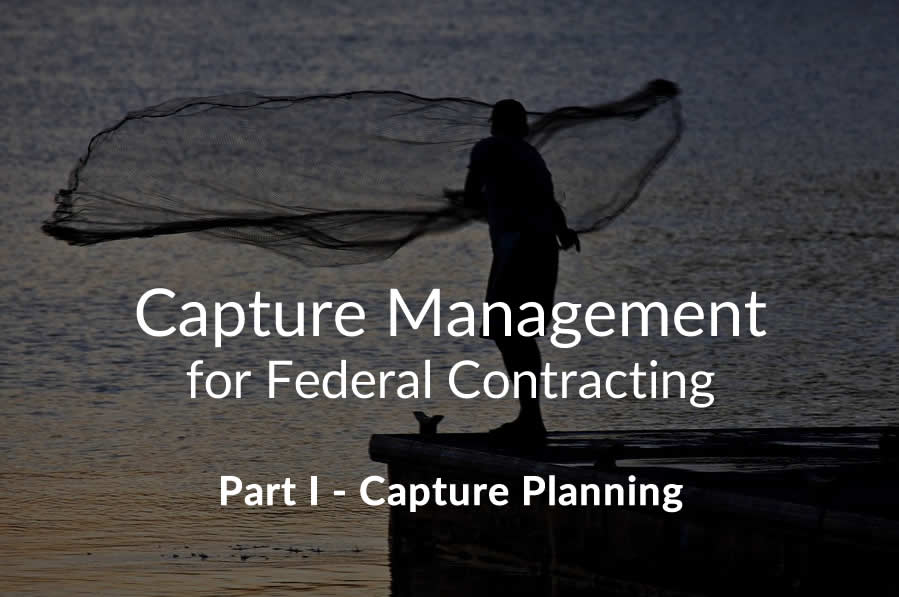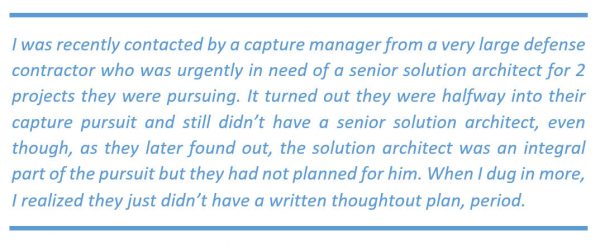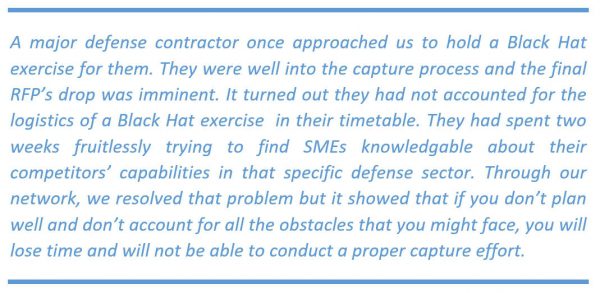This is the first part of a series of articles on Capture Management in which we will look at the different aspects of the process from different angles and see where are the bottlenecks, where most companies are failing, and where you can focus on getting a higher ROI in your capture pursuits. Note that we are looking at Capture Management from the perspective of Federal and State opportunities and not commercial capture practices, although these articles can be helpful in that context as well.
The first part of the series will focus on Capture Planning because we think it is the most overlooked and least appreciated part of the capture process. We will see why it is the backbone of an effective capture strategy and why you should spend quite a long time on it, refining and strengthening it before actually starting any capture project.
Part I – Capture Planning
Capture Planning – Why do you need it??
Contrary to Lincoln’s saying that “give me six hours to chop down a tree and I will spend the first four sharpening the ax,” human beings, who are a restless species, want to jump right into the mud from day one. People are always annoyed when asked to plan for something and many times, even if they do it, they do it just to say that they did it! But in reality, they are not going to use that plan.
But why would you really need to spend your and your team’s valuable time on planning for your capture pursuit? Well, the answer is clear. If you don’t, your capture pursuit will fail. Don’t think that only small companies fail in this; see the below call-out box that is about a large defense contractor.
Let’s start with the most straightforward reason: if you don’t get your management behind you for your pursuit (that includes budgetary approval), as soon you start, you are going to run into disagreements with the management heads-on, who won’t accept your methodology, your costs, your timings, etc. So, you need first to get their approval, and for that, you need to present them with a plan.
Secondly, you have a finite amount of time and resources to spend on each capture pursuit. How are you going to plan your time/resources depends on having a well laid out pursuit plan. If you don’t do that, you will wake up and see that you are halfway into the project, and you still do not have the pillars of a good capture process in place; you are behind in time and intelligence, and no concrete actions have been taken.
Lastly, if you don’t plan to have the right team for your capture pursuit, you can’t count on filling the gaps when you are half-way into the project.
Thus, the goal is to prepare a written, action-oriented capture plan. Although the length or complexity of the plan may vary, a written plan offers reviewable evidence of the quality of thinking of the planners and the soundness of the program. Also, the primary audience for a capture plan are all those who will either manage or execute the plan.
The Benefits of Capture Planning?
Per our experience, companies who have a formal capture planning discipline will heavily benefit by having:
- A better and more in-depth understanding of each opportunity
- More effective solutions and capture strategies
- Enhanced bid decisions
- Greater internal consensus (the team and management)
- More effective intelligence
- Better preparation for the Proposal phase
- Higher Win rates
- Reduced Costs
Capture Plan Content
Although each company can devise its unique structure for the capture plan, similar to an operational plan for a battle, each capture plan must cover a few set areas to be practical and effective:
- Opportunity Description
- Customer Analysis
- Competitive Analysis
- Internal Analysis
- Strategy and Implementation Plan
- Execution and Monitoring
A useful capture plan will be realistic and specific, detailing the objective, the action, who is responsible for it, timing, and the frequency of review.
1. Opportunity Description
The opportunity description part should clearly specify the opportunity name, any known background with dates, any connections to the mission or vision or goals, the requirements and the deliverables. Finally it should contain a schedule of events as far as is known to us.
2. Customer Analysis
The customer analysis should cover a discussion of the customer’s organization and how it works, what are their buying trends, what are their usual evaluation process, what are their hot buttons, issues, and pain points, and what are their typical buying process.
3. Competitive Analysis
The competitive analysis should cover a SWOT analysis as well as a discussion on what the expected approach & strategy should be. Shipley suggests that you should fill out an “Integrated Prospect Solution Worksheet” at this point, which is essentially a list of customer’s requirements (or issues) and how you, as well as your competitors, fare and what should be your strategy and action plan for it. Holding Black Hat exercises (when appropriate) is also planned for (not executed) here.
4. Internal Analysis
Now that you have assessed the enemy, it is now time to gauge the friendly forces. You need to look into your (and your possible teammates’) pasts performance, do a cost and price analysis, assess your probable solution, and conduct a risk analysis. The aim is an early definition of a solution that enables you to influence the customer’s requirements and specifications and to select the best teaming partners.
5. Strategy and Implementation Plan
Up to this point, you have been preparing your ammunition for thought = strategy. Now is the time to propose your win strategy and then how you are going to implement this capture strategy. This is essentially a series of plans aimed at determining what actions to take to position your company against the customer’s needs. You should cover how you will collect the needed intelligence, whom you will call or contact, how you will conduct your public relations/communications, what steps you will take to mitigate risks and risk management as a whole, what steps you will take (if any) towards any technology development, , a preparation plan for the proposal development, a contingency plan, and finally a timetable with specific review milestones to top it off.
6. Execution and Monitoring
You need to hold a kickoff meeting that will include all the stakeholders and, most importantly, all the staff who will participate in the actual implementation or who will manage and have a say as the plan develops. Reviews should also be held periodically, based on the set timetable, and should include all the stakeholders and the implementers.
Dos and Don’ts
1. Keep the process flexible: Hit a balance between the resources you can commit and the importance of the pursuit to your company. Remember that resource allocation can be a variable of time and needs, so you don’t need to have all the eggs in the basket from day 1.
2. Keep the Process Current: You need to ensure that reviews are held periodically to check the course of the capture pursuit. Interactive discussions can be quick and fruitful.
3. Maintain a balance between planning and execution:
- Having a too detailed a plan with little actionable items is a waste of your staff time
- If your plan requires so many resources that it is undoable, either consider simplifying the plan or if essentials are at stake, considering questioning your pursuit decision.
4. Never omit conducting a competitive analysis or a requirements analysis, even if you are short of time. Both are a must, go hand-in-hand and are crucial to your capture strategy and give you a picture as to how you are positioned with respect to the competitors and in front of the customer.
5. Always have senior management’s approval for your capture plan. If you don’t have it, don’t start. Conversely, make sure that all of them are fully aware of it and approve of it. Try to update them as you go even if they don’t attend the review sessions. Be proactive in reaching out to them and continually briefing them and getting them involved.
6. A properly thought out staffing plan is an essential part of a capture plan. The selection of the capture manager for a pursuit is critical to the success of that pursuit. Competitive contractors always assign their best resources to capture management. But that is not all. If your pursuit is solution-oriented, you might perhaps need a solution architect in the team. You should also consider the competitive intelligence gathering and people for that, the PTW and Black Hat Exercise (if required), and plan accordingly. Remember that if you want to win on the opportunities, you need to assign your best resources to the capture process, as capture sows the seeds of success, i.e. winning the opportunity.
7. A capture plan without a timetable with measurable objectives is nothing but a piece of paper. Ensure that tasks are properly assigned, are given reasonable execution times that are realistic, and are clear to those assigned. Then make sure that the people assigned to them have the time to actually perform those tasks, as usually they might be involved part-time. Then measure your progress based on the task assignments and the set milestones and correct your performance accordingly.
8. Your timetable should also include progress review dates. Never omit or cancel reviews. They are your means to ensure that your capture plan is progressing as planned and that all those involved are on the same wavelength. Remember that reviews are not to question the underlying data or assumptions. Do that only when major objectives are not met, or new intel/data is found that negates the previous assumptions. Instead, reviews should be quick and easy. Focus on reviewing the actions taken, what the results have been, and what needs to be adjusted. Additionally, one of the major themes of all reviews should be the constant question of Bid/No-Bid.
9. Get your proposal team involved. Yes, you read it correctly. We didn’t say get your capture team involved in the proposal process. Instead, in your Capture Plan, you should plan to get your proposal team involved as early as you can in the capture process. The main reason for this is that your proposal team must have a sense of possession of the opportunity. Many times when the Capture Team hands over the information to the Proposal Team, there is a disconnect and sometimes even resistance, with the proposal team being reluctant to go after the opportunity. There are two approaches to resolve this. Some companies try to get the Capture Manager and Capture Team involved in the proposal development process. This can be helpful but still will not resolve the possible “rivalries” on the part of the proposal team. And when your team is not 100% committed to winning, you are going to lose. On the contrary, getting the proposal team involved in the capture process will remove these barriers and the possible departmental rivalries. The proposal team will see itself as part of the pursuit and as one team with the rest of the capture team. When it comes to proposal writing, they will certainly write to win.
Capture planning is perhaps the most important part of any capture pursuit. Competitive contractors spend quite some time on sharpening their axes before chopping down the tree. You should do too.



